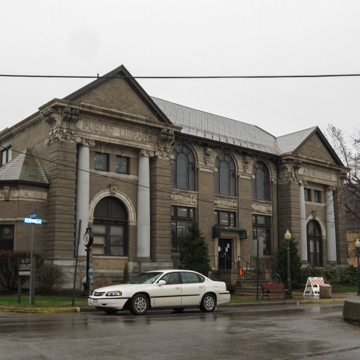You are here
Oil City Public Library (Carnegie Public Library)
The women of Oil City wrote to Andrew Carnegie in 1899 requesting $25,000 to build a library for their town of 11,000 people. Carnegie increased the donation to $40,000 to reflect his belief that Oil City was one of the key components of the steel industry, and as such would continue to grow. Charles Weber Bolton (1855–1942) of Philadelphia designed an eclectic two-story, brick building with gray granite trim, a red tiled roof, and round-arched windows and entrances that blends Renaissance Revival and Beaux-Arts classicism, with a dash of Richardsonian Romanesque. Perhaps due to his familiarity with church design, Bolton added an apselike bay window arrangement on the south elevation.
The entrance probably was moved from the east end of the building to the center of the Central Avenue elevation in the 1950s, when an interior redesign took place and the name was changed from the Carnegie Public Library to the Oil City Library. A one-story modern Renaissance-style addition of 6,500 square feet designed by the W. G. Eckles Company Architects on the west elevation opened in 1980.
Writing Credits
If SAH Archipedia has been useful to you, please consider supporting it.
SAH Archipedia tells the story of the United States through its buildings, landscapes, and cities. This freely available resource empowers the public with authoritative knowledge that deepens their understanding and appreciation of the built environment. But the Society of Architectural Historians, which created SAH Archipedia with University of Virginia Press, needs your support to maintain the high-caliber research, writing, photography, cartography, editing, design, and programming that make SAH Archipedia a trusted online resource available to all who value the history of place, heritage tourism, and learning.











